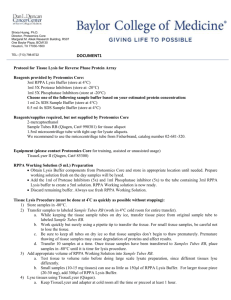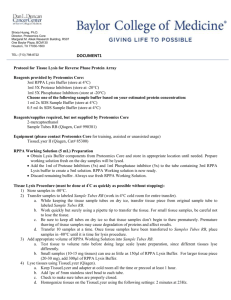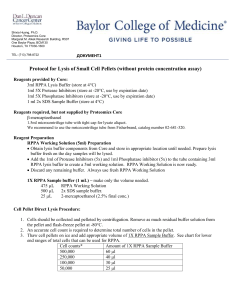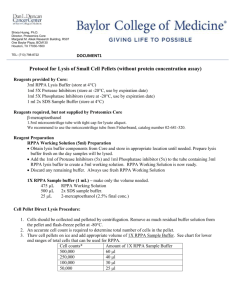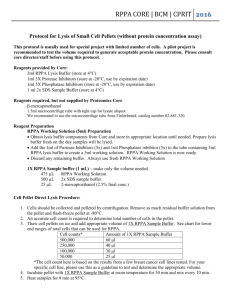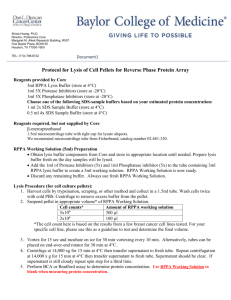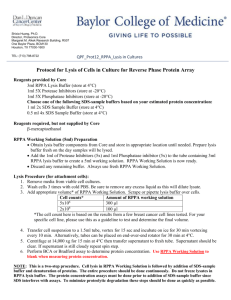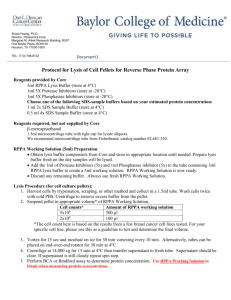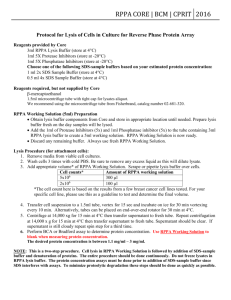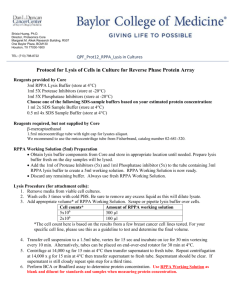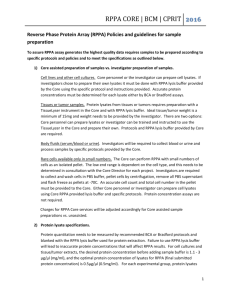Protocol for Tissue Lysis
advertisement
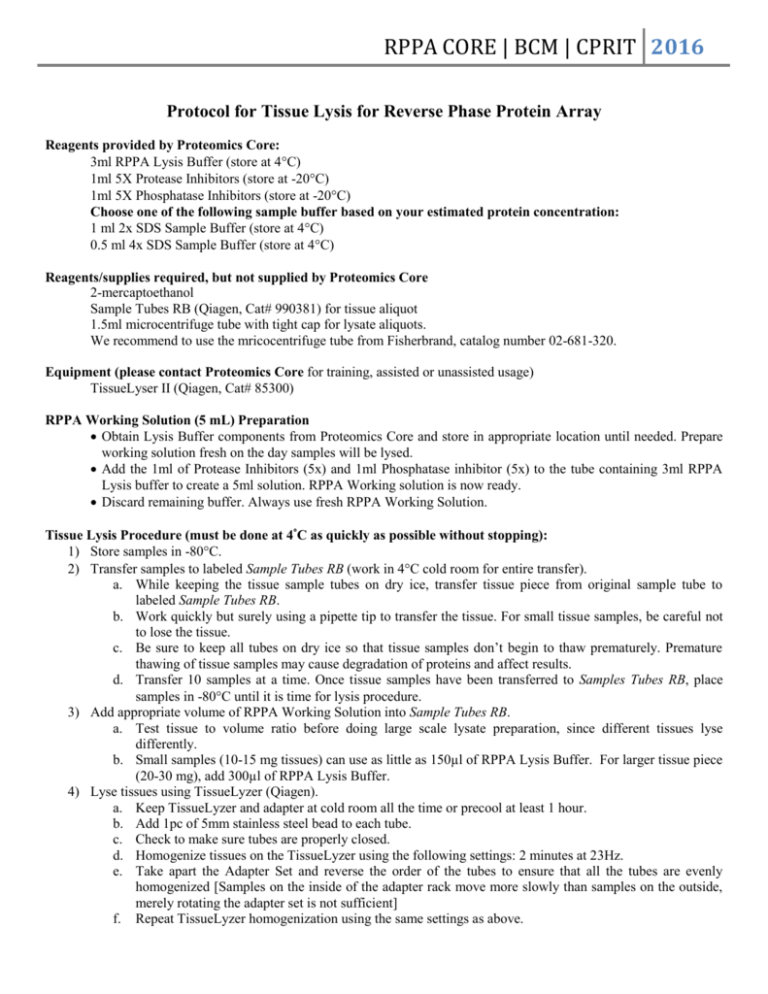
RPPA CORE | BCM | CPRIT 2016 Protocol for Tissue Lysis for Reverse Phase Protein Array Reagents provided by Proteomics Core: 3ml RPPA Lysis Buffer (store at 4C) 1ml 5X Protease Inhibitors (store at -20C) 1ml 5X Phosphatase Inhibitors (store at -20C) Choose one of the following sample buffer based on your estimated protein concentration: 1 ml 2x SDS Sample Buffer (store at 4C) 0.5 ml 4x SDS Sample Buffer (store at 4C) Reagents/supplies required, but not supplied by Proteomics Core 2-mercaptoethanol Sample Tubes RB (Qiagen, Cat# 990381) for tissue aliquot 1.5ml microcentrifuge tube with tight cap for lysate aliquots. We recommend to use the mricocentrifuge tube from Fisherbrand, catalog number 02-681-320. Equipment (please contact Proteomics Core for training, assisted or unassisted usage) TissueLyser II (Qiagen, Cat# 85300) RPPA Working Solution (5 mL) Preparation Obtain Lysis Buffer components from Proteomics Core and store in appropriate location until needed. Prepare working solution fresh on the day samples will be lysed. Add the 1ml of Protease Inhibitors (5x) and 1ml Phosphatase inhibitor (5x) to the tube containing 3ml RPPA Lysis buffer to create a 5ml solution. RPPA Working solution is now ready. Discard remaining buffer. Always use fresh RPPA Working Solution. Tissue Lysis Procedure (must be done at 4C as quickly as possible without stopping): 1) Store samples in -80C. 2) Transfer samples to labeled Sample Tubes RB (work in 4C cold room for entire transfer). a. While keeping the tissue sample tubes on dry ice, transfer tissue piece from original sample tube to labeled Sample Tubes RB. b. Work quickly but surely using a pipette tip to transfer the tissue. For small tissue samples, be careful not to lose the tissue. c. Be sure to keep all tubes on dry ice so that tissue samples don’t begin to thaw prematurely. Premature thawing of tissue samples may cause degradation of proteins and affect results. d. Transfer 10 samples at a time. Once tissue samples have been transferred to Samples Tubes RB, place samples in -80C until it is time for lysis procedure. 3) Add appropriate volume of RPPA Working Solution into Sample Tubes RB. a. Test tissue to volume ratio before doing large scale lysate preparation, since different tissues lyse differently. b. Small samples (10-15 mg tissues) can use as little as 150µl of RPPA Lysis Buffer. For larger tissue piece (20-30 mg), add 300µl of RPPA Lysis Buffer. 4) Lyse tissues using TissueLyzer (Qiagen). a. Keep TissueLyzer and adapter at cold room all the time or precool at least 1 hour. b. Add 1pc of 5mm stainless steel bead to each tube. c. Check to make sure tubes are properly closed. d. Homogenize tissues on the TissueLyzer using the following settings: 2 minutes at 23Hz. e. Take apart the Adapter Set and reverse the order of the tubes to ensure that all the tubes are evenly homogenized [Samples on the inside of the adapter rack move more slowly than samples on the outside, merely rotating the adapter set is not sufficient] f. Repeat TissueLyzer homogenization using the same settings as above. g. Examine each tube after homogenization. Repeat homogenization if tissue pieces can still be seen. 5) Spin at 14,000 xg for 15 min at 4C then transfer supernatant to fresh tube. Repeat centrifugation two more times at 14,000 x g for 15 min at 4C then transfer supernatant to fresh tube. Supernatant should be clear (i.e. no fats or particulates). If supernatant is still cloudy repeat spin step. Tissue samples typically require 3 or more spins to remove debris and floating fatty layer. Especially fatty tissues (i.e. breast cells) may require even more spins. 6) Determine protein concentration using BCA Assay or Bradford. Use RPPA Working Solution as blank and diluent for standards and samples when measuring protein concentration. The desired protein concentration is between 1.1 mg/ml – 3 mg/ml. 7) Prepare the lysates for RPPA analysis by adding SDS Sample Buffer, -mercaptoethanol, and RPPA Working Solution to obtain a final concentration of 0.5mg/ml. Depending on your protein concentration, choose one of the tables below to prepare the final RPPA ready samples. NOTE: Prepare all your samples the same way using the same type of SDS Sample buffer. For lysates≥1.1mg/ml For lysates<1.1mg/ml __µl Lysate __µl Lysate __µl RPPA Working Solution __µl RPPA Working Solution 60µl 2X SDS Sample Buffer 30µl 4X SDS Sample Buffer 3.0µl -mercaptoethanol (2.5% final concentration) 3.0µl -mercaptoethanol 120µl Total Volume 120µl Total Volume 8) Heat samples for 8 min at 100C. 9) Bring to room temp & spin down to collect volumes. 10) Aliquot into two (02) tubes (please use 1.5ml microcentrifuge tube with tight cap to avoid sample loss during heating) Tube #1 and #2: 50µl each If your sample volume is low, please contact us for advice and DON’T just distribute it evenly between #1 & #2 tubes! Please figure out your condition in advance. 11) Clearly label sample tubes and put them into a freezer/cardboard box labeled with your name/PI name, contact number/date etc. Label tubes as follows: PI initials_Auto# (ex: SH_1) SH_1 RPPA-50ul SH_1 RPPA-50ul Label freezer/cardboard box as follows: Investigator Name/PI name Contact number Date 12) Store tubes at -80C. 13) Send your RPPA_Sample Submission Form by email before you deliver your samples to the Core. 14) Deliver samples on dry ice to the Core. *DO NOT use homemade or any other concentration of SDS Sample Buffer as they have not been validated for this platform. RPPA CORE | BCM | CPRIT 2016 **Use the same SDS Sample Buffer (whether 2x or 4x) for all your samples. DO NOT prepare some samples in 4X and some samples in 2X Sample Buffer.
